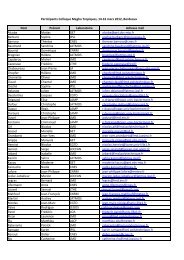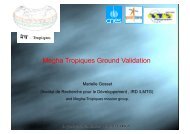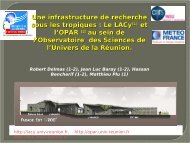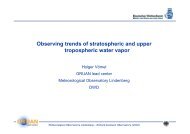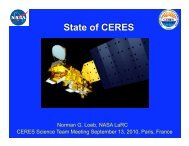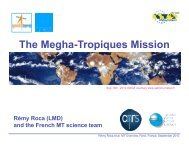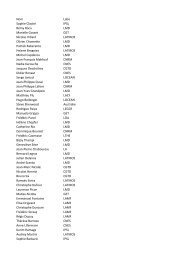Les caractéristiques de l'échantillonage de MT - Megha-Tropiques
Les caractéristiques de l'échantillonage de MT - Megha-Tropiques
Les caractéristiques de l'échantillonage de MT - Megha-Tropiques
You also want an ePaper? Increase the reach of your titles
YUMPU automatically turns print PDFs into web optimized ePapers that Google loves.
Michel Cap<strong>de</strong>rou<br />
LMD<br />
19/01/2005 <strong>MT</strong> / Echantillonnage 1
19/01/2005 <strong>MT</strong> / Echantillonnage 2
19/01/2005 <strong>MT</strong> / Echantillonnage 3
19/01/2005 <strong>MT</strong> / Echantillonnage 4
19/01/2005 <strong>MT</strong> / Echantillonnage 5
Trace entre 20°N et 20°S<br />
<br />
Heure <strong>de</strong> passage variable - cycle<br />
par rapport au Soleil : 51 jours<br />
19/01/2005 <strong>MT</strong> / Echantillonnage 6
19/01/2005 <strong>MT</strong> / Echantillonnage 7
19/01/2005 <strong>MT</strong> / Echantillonnage 8
19/01/2005 <strong>MT</strong> / Echantillonnage 9
! <br />
<br />
<br />
La fauchée dépend <strong>de</strong> l’instrument<br />
considéré<br />
Elle est caractérisée par l’angle <strong>de</strong><br />
<strong>de</strong>mi-fauchée (f) ou l’angle <strong>de</strong><br />
visée zénithale (z)<br />
Et par le mo<strong>de</strong> <strong>de</strong> fauchée :<br />
orthogonale ou conique<br />
19/01/2005 <strong>MT</strong> / Echantillonnage 10
" # " $<br />
<br />
<br />
<br />
ScaRaB : f. orthogonale, f=48.9°<br />
MADRAS : f. conique, z=53°<br />
SAPHIR : f. orthogonale, f=45°<br />
19/01/2005 <strong>MT</strong> / Echantillonnage 11
! %<br />
" & "<br />
<br />
<br />
<br />
ScaRaB : <strong>de</strong> 30.0°N à 30.0°S<br />
MADRAS : <strong>de</strong> 27.6°N à 27.6°S<br />
SAPHIR : <strong>de</strong> 28.4°N à 28.4°S<br />
19/01/2005 <strong>MT</strong> / Echantillonnage 12
' <br />
19/01/2005 <strong>MT</strong> / Echantillonnage 13
' <br />
19/01/2005 <strong>MT</strong> / Echantillonnage 14
' <br />
19/01/2005 <strong>MT</strong> / Echantillonnage 15
Comment le satellite voit sa cible (lieu donné par<br />
sa latitu<strong>de</strong> et sa longitu<strong>de</strong>) <br />
A quel moment (échantillonnage temporel)<br />
Sous quel angle (échantillonnage angulaire)<br />
19/01/2005 <strong>MT</strong> / Echantillonnage 16
(<br />
19/01/2005 <strong>MT</strong> / Echantillonnage 17
(<br />
19/01/2005 <strong>MT</strong> / Echantillonnage 18
(<br />
19/01/2005 <strong>MT</strong> / Echantillonnage 19
(<br />
19/01/2005 <strong>MT</strong> / Echantillonnage 20
(<br />
19/01/2005 <strong>MT</strong> / Echantillonnage 21
(<br />
19/01/2005 <strong>MT</strong> / Echantillonnage 22
(<br />
19/01/2005 <strong>MT</strong> / Echantillonnage 23
$<br />
19/01/2005 <strong>MT</strong> / Echantillonnage 24
) <br />
19/01/2005 <strong>MT</strong> / Echantillonnage 25
) <br />
19/01/2005 <strong>MT</strong> / Echantillonnage 26
) <br />
19/01/2005 <strong>MT</strong> / Echantillonnage 27
) <br />
19/01/2005 <strong>MT</strong> / Echantillonnage 28
* * +<br />
" # " " "<br />
Springer, 2003.<br />
19/01/2005 <strong>MT</strong> / Echantillonnage 29




